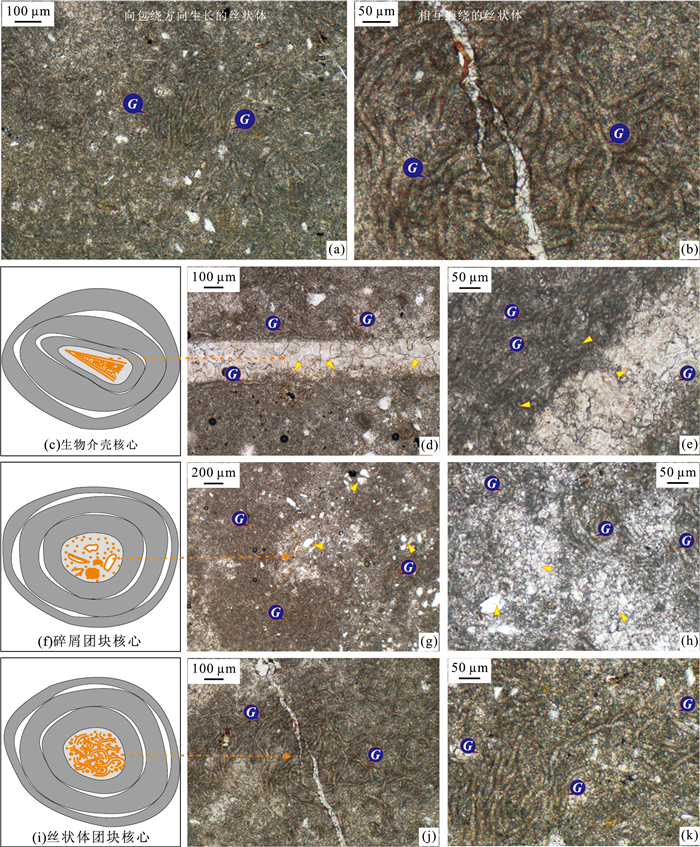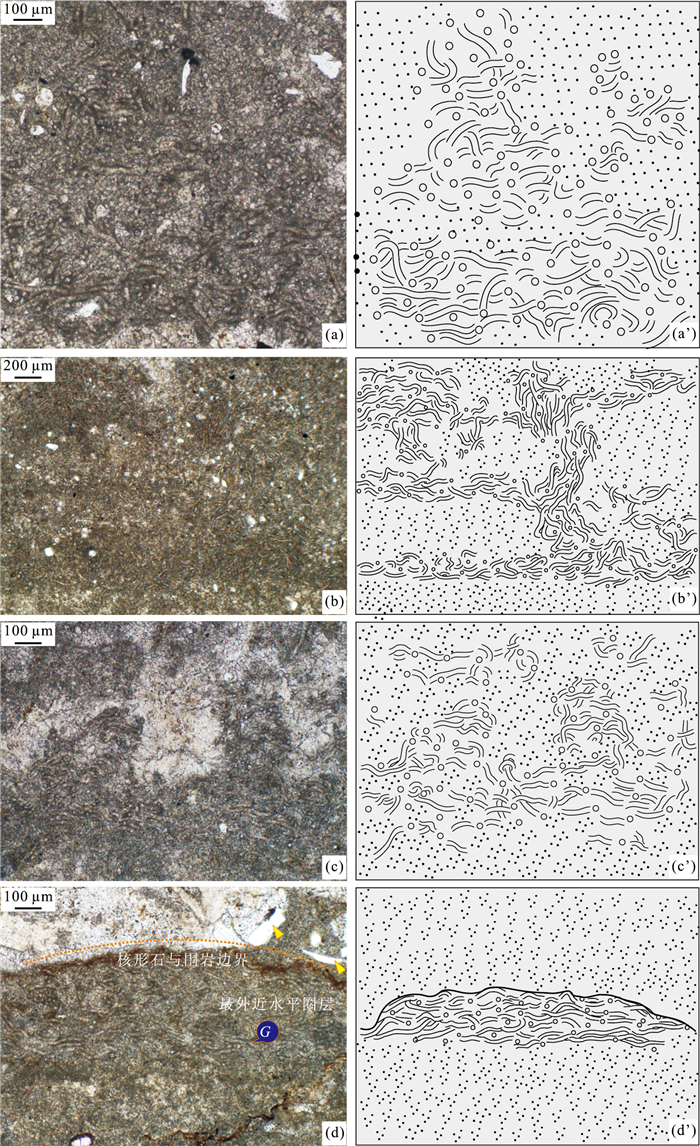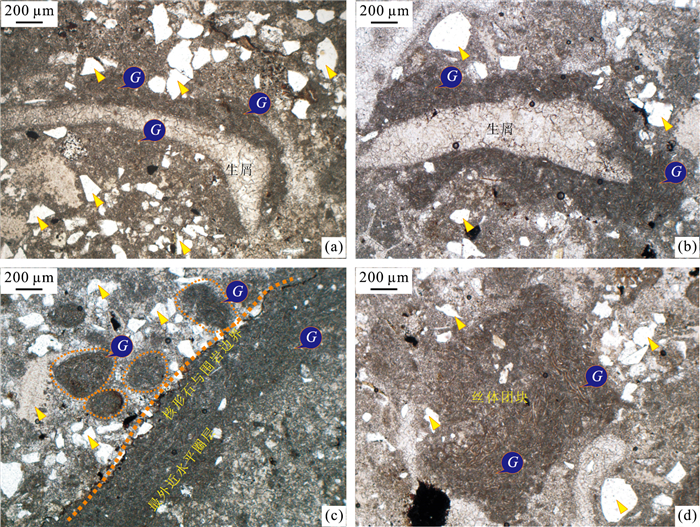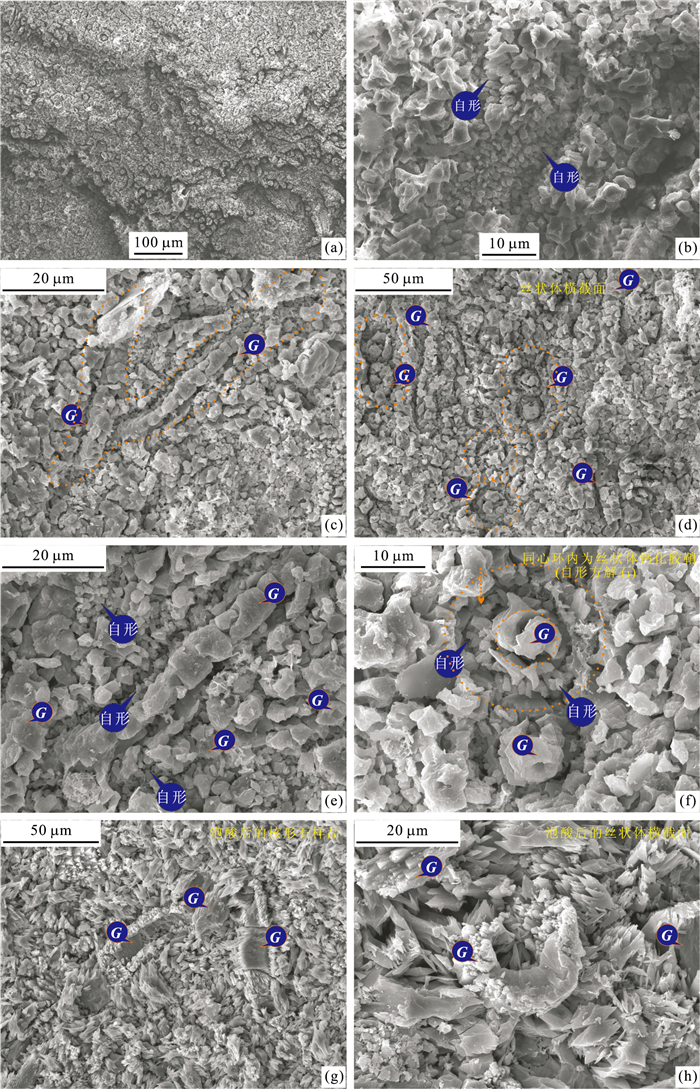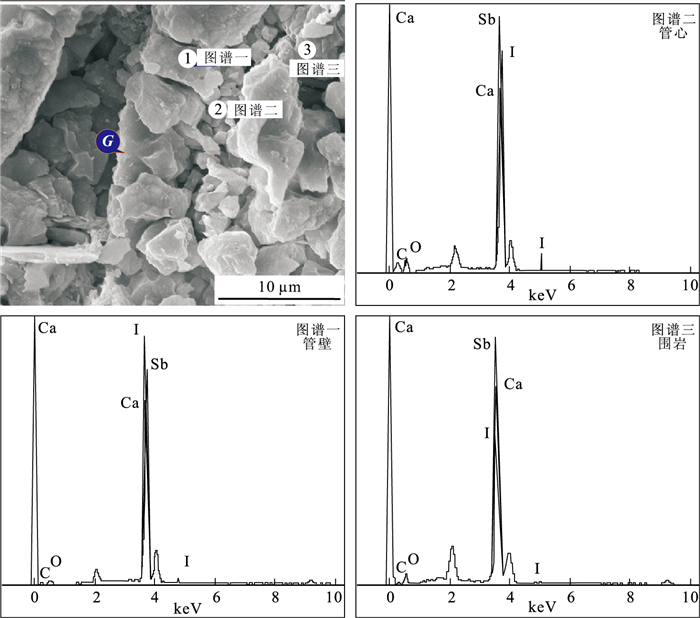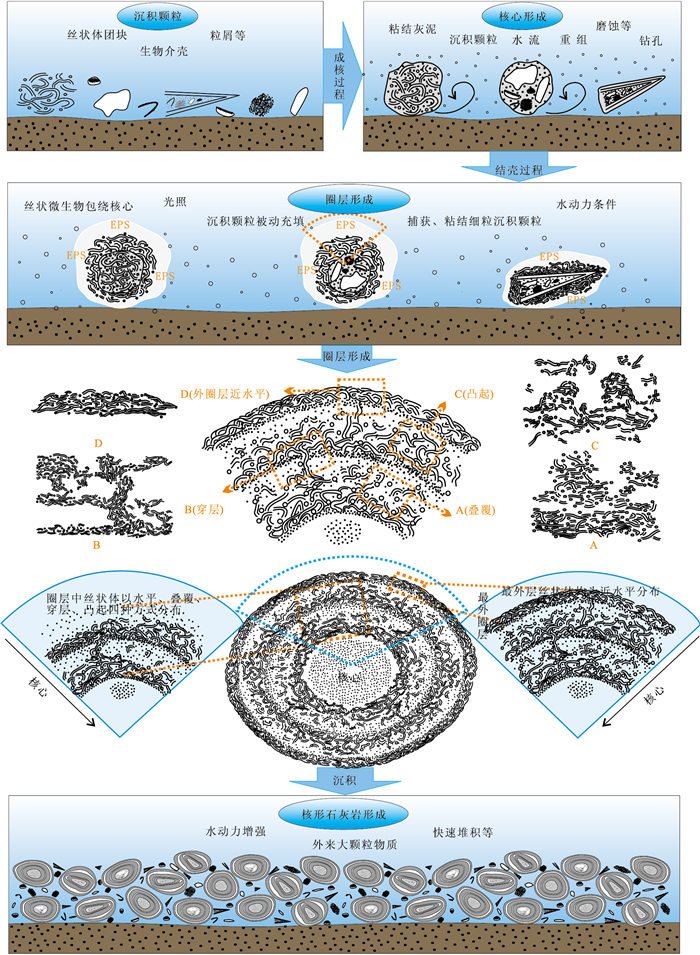Girvanella in Oncoids from the Mantou Formation (Cambrian Series 3), Mianchi, Western Henan
-
摘要: 寒武纪微生物岩中的Girvanella化石在地层中广泛分布,这为微生物参与微生物岩的形成提供了更直观的证据.豫西渑池地区寒武系第三统馒头组二段碳酸盐岩中发育了数量丰富的微生物岩类型——核形石,其核心、纹层及围岩中保存的Girvanella丝状体化石具有密度大、完整度高的特点.对核形石的微观分析表明,其核心、包壳等各个部位均大量保存有Girvanella丝状体.这些丝状体为任意弯曲、不分节、不分枝的管状集合体,单管直径约为20 μm,最大延伸长度约为400 μm.核形石核心以丝状体包绕的灰泥团块或砾屑为特征,局部可见丝状体包绕生物碎屑成核;包壳内的丝状体多出现在暗色纹层中,其分布表现为缠绕叠覆、穿层、凸起和匍匐(或水平状)这4种方式.在核形石的任意部位,Girvanella丝状体均具有相似的分布形式,表明它们的生长条件是相似的.核形石中Girvanella丝状体的大量出现与其形成于低能的滨岸鲕粒滩滩间或滩后低洼地带有关,这种低能条件对Girvanella的生长及保存十分有利.对研究区核形石中的Girvanella化石在微生物岩中的分布特征、微组构等的进一步研究将为寒武纪其他微生物岩的成因及微生物与环境的相互作用提供重要实证.Abstract: Girvanella filaments in the microbialite are widely distributed in Cambrian, which provide more visual evidences for the participation of microorganism in the formation of the microbialite. Abundant oncoids, a kind of microbialite, occur in the carbonates from the Second Member of the Mantou Formation (Cambrian Series 3), Mianchi area, western Henan. The Girvanella filaments which are preserved in the nuclei, cortices and surrounding rocks exhibit large density and high integrity. The microscopic analysis on the oncoids shows that the Girvanella filaments are preserved in both of the nucleus and cortex of oncoids. The filaments appear as a flexuous, unsegmented and unbranched tubular colony. Each individual is about 20 μm in diameter and 400 μm in maximum extended length. They are mainly densely winding, being intertwined with each other with irregular distribution. The nucleus of oncoids is dominated by filaments surrounding lime clumps and debris, occasionally the bioclasts. The filaments in the cortex of oncoids mainly occur in dark laminae and exhibit four kinds of growth patterns including winding and intertwined, trans-laminar, convex and bedding-arrangement. Girvanella filaments share the similar growth pattern no matter where they occur in oncoids, showing that they have similar growth condition. The mass occurrence of Girvanella filaments in oncoids has much to do with their growth condition of low-energy coastal oolitic inter-shoal or back-shoal facies. This kind of low-energy condition faclitates the growth and preservation of Girvanella filaments. Further studies on the distribution characteristics and micro-fabrics of the Girvanella filaments which were well preserved in the oncoids in the study area are expected to offer significant evidences for the genesis analysis of other microbialite in Cambrian and for the interaction between microorganism and environment.
-
Key words:
- Mianchi area /
- Cambrian Series 3 /
- oncoids /
- Girvanella /
- Mantou Formation /
- stratigraphy
-
图 1 地质背景、地层序列及核形石特征
a.华北地台寒武纪第三世毛庄期沉积相分布,据冯增昭等(1990)修改;b.渑池地区寒武系第三统馒头组二段含核形石地层序列;c~f馒头组二段下部含核形石层;c.野外露头剖面;d.野外露头平面;e.独立的核形石个体;f.核形石中的明暗纹层
Fig. 1. Geological background, stratigraphic succession and the features of oncoids
图 2 Girvanella微结构特征及丝状体在核形石核心中的分布
a和b.核形石中的Girvanella丝状体;c.以生物介壳为核心的核形石;d和e为c的细节显微照片,其中黄色箭头部分为c中核形石核心内生物介壳及其边缘的微生物钻孔;f.以碎屑团块为核心的核形石;g和h为f的细节显微照片,其中黄色箭头所指为f中核心中内碎屑团块中的石英颗粒、生物碎屑、丝状体碎片等;i.以丝状体团块为核心的核形石; j和k为i核心内相互缠绕的Girvanella丝状体(G:Girvanella缩写)
Fig. 2. The microfabrics and distribution of Girvanella filaments in the core of oncoids
-
Dahanayake, K., 1978.Sequential Position and Environmental Significance of Different Types of Oncoids.Sedimentary Geology, 20:301-316.doi: 10.1016/0037-0738(78)90060-x Dai, M.Y., Qi, Y.A., Chang, Y.G., et al., 2014.Oncoids and Their Significance from the Second Member of the Mantou Formation (Cambrian Series 3), Dengfeng Area, Henan.Acta Sediemntologica Sinica, 32(3):410-417 (in Chinese with English abstract). http://www.cjxb.ac.cn/EN/abstract/abstract1065.shtml Dang, H.W., Liu, J.B., Yuan, X.P., 2009.Microbialites in the Middle Cambrian Qinjiamiao Group in Xingshan, Hubei Province:Implication for Paleoenvironmental Reconstruction.Acta Scientiarum Naturalium Universitatis Pekinensis, 45(2):289-298 (in Chinese with English abstract). http://en.cnki.com.cn/Article_en/CJFDTOTAL-BDXP200802007.htm Duan, K.B., Duan, D.S., Chen, L.Q., et al., 2008.Progress and Problems in Microbial Carbonates Research.Northwestern Geology, 41(1):44-49 (in Chinese with English abstract). https://www.researchgate.net/publication/289772028_Progress_and_problems_in_microbial_carbonates_research Feng, Z.Z., Wang, Y.H., Zhang, J.S., 1990.Lithofacies Palaeogeography of Early Paleozoic of North China Platform.Geological Publishing House, Beijing (in Chinese). Gao, J.P., Zhu, S.X., 1998.Cambrian Microbialites from the Northeastern Shanxi Province and Their Relation to Sedimentary Environments.Acta Micropalaeontologica Sinica, 15(2):60-71 (in Chinese with English abstract). http://en.cnki.com.cn/Article_en/CJFDTotal-WSGT802.004.htm Guo, J.F., Li, Y., Shu, D.G., et al., 2010.Characteristics and Formation Process of Nodules from Yanjiahe Formation, Terreneuvian of the Three Gorge Area, South China.Acta Sedimentologica Sinica, 28(4):676-681 (in Chinese with English abstract). http://en.cnki.com.cn/Article_en/CJFDTOTAL-CJXB201004003.htm Hägele, D., Leinfelder, R., Grau, J., et al., 2006.Oncoids from the River Alz (Southern Germany):Tiny Ecosystems in a Phosphorus-Limited Environment.Palaeogeography, Palaeoclimatology, Palaeoecology, 237(2-4):378-395.doi: 10.1016/j.palaeo.2005.12.016 Jones, B., 2011.Biogenicity of Terrestrial Oncoids Formed in Soil Pockets, Cayman Brac, British West Indies.Sedimentary Geology, 236(1-2):95-108.doi: 10.1016/j.sedgeo.2010.12.009 Kazmierczak, J., Coleman, M.L., Gruszczynski, M., et al., 1996.Cyanobacterial Key to the Genesis of Micritic and Peloidal Limestones in Ancient Seas.Acta Palaeontologica Polonica, 41(4):319-338. https://www.researchgate.net/publication/249334862_Cyanobacterial_key_to_the_genesis_of_micritic_and_peloidal_limestones_in_ancient_seas Li, X.Z., Guan, S.R., Xie, Q.B., et al., 2000.The Oncoids Genesis in the Middle Member of the Guanzhuang Formation of Eocene in Pingyi Basin.Acta Petrologica Sinica, 16(2):261-268 (in Chinese with English abstract). http://www.oalib.com/paper/1471375 Peryt, T.M., 1983.Oncoids:A Comment to Recent Developments.In:Peryt, T.M., ed., Coated Grains.Springer, New York, 273-275. doi: 10.1007/978-3-642-68869-0_23 Pratt, B.R., 1995.The Origin, Biota and Evolution of Deep-Water Mud-Mounds.In:Monty, C.L.V., Bosence, D.W.J., Pratt, B.R., eds., Carbonate Mud-Mounds:Their Origin and Evolution.Sedimentology & Stratigraphy, 23:49-123. doi: 10.1002/9781444304114.ch3/summary Pratt, B.R., 2000.Microbial Contribution to Reefal Mud-Mounds in Ancient Deep-Water Settings:Evidence from the Cambrian.In:Riding, R.E., Awramik, S.M., eds., Microbial Sediments.Springer-Verlag, Berlin, 282-288. doi: 10.1007/978-3-662-04036-2_30 Qi, Y.A., Dai, M.Y., Chang, Y.G., et al., 2013.The Oncoids from the Second Member of Mantou Formation (the Third Series, Cambrian), Mianchi Area, Western Henan Province.Geological Journal of China Universities, 19(4):634-641 (in Chinese with English abstract). http://www.en.cnki.com.cn/Article_en/CJFDTotal-GXDX201304009.htm Riding, R., 1991.Calcareous Algae and Stromatolites.Springe-Verlag, Heideberg, 21-51. Shi, G.R., Chen, Z.Q., 2006.Lower Permian Oncolites from South China:Implications for Equatorial Sea-Level Responses to Late Palaeozoic Gondwanan Glaciation.Journal of Asian Earth Sciences, 26(3):424-436.doi: 10.1016/j.jseaes.2005.10.009 Wen, Z.F., Zhong, J.H., Li, Y., et al., 2004.Current Study on Genesis and Formation Conditions of Stromatolites.Geological Journal of China Universities, 10(3):418-428 (in Chinese with English abstract). http://en.cnki.com.cn/Article_en/CJFDTOTAL-GXDX200403011.htm Yang, R.C., Fan, A.P., Han, Z.Z., et al., 2011.Status and Prospect of Studies on Oncoid.Advances in Earth Science, 26(5):465-474 (in Chinese with English abstract). http://www.adearth.ac.cn/EN/abstract/abstract8740.shtml Zhang, W.H., Shi, X.Y., Tang, D.J., et al., 2014a.Oncolites from Lower-Middle Cambrian Transition of the Western North China Platform:A Study of Their Ultra-Fabrics and Biomineralization.Geoscience, 28(1):1-15 (in Chinese with English abstract). https://www.researchgate.net/publication/51178432_Distribution_of_Microfossils_Within_Polymetallic_Nodules_Biogenic_Clusters_Within_Manganese_Layers Zhang, W.H., Shi, X.Y., Tang, D.J., et al., 2014b.Mass-Occurrence of Oncoids in the Early-Middle Cambrian Transition at Western Margin of North China Platform:A Response of Microbial Community to Shallow Marine Anoxia.Journal of Palaeogeography, 16(3):305-318 (in Chinese with English abstract). doi: 10.1111/j.1472-4669.2011.00309.x/abstract 代明月,齐永安,常玉光,等,2014.河南登封地区寒武系第三统馒头组二段中的核形石及其意义.沉积学报,32(3): 410-417. http://www.cnki.com.cn/Article/CJFDTOTAL-CJXB201403002.htm 党皓文,刘建波,袁鑫鹏,2009.湖北兴山中寒武统覃家庙群微生物岩及其古环境意义.北京大学学报(自然科学版),45(2): 289-298. http://www.cnki.com.cn/Article/CJFDTOTAL-BJDZ200902020.htm 段凯波,段东生,陈留勤,等,2008.微生物碳酸盐岩研究进展及存在的问题.西北地质,41(1): 44-49. http://www.cnki.com.cn/Article/CJFDTOTAL-XBDI200801005.htm 冯增昭,王英华,张吉森,1990.华北地台早古生代岩相古地理.北京:地质出版社. 高建平,朱士兴,1998.晋东北地区寒武系微生物岩及其与沉积环境的关系.微体古生物学报,15(2): 60-71. http://www.cnki.com.cn/Article/CJFDTOTAL-WSGT802.004.htm 郭俊锋,李勇,舒德干,等,2010.湖北宜昌纽芬兰统岩家河组结核的特征及形成过程.沉积学报,28(4): 676-681. http://www.cnki.com.cn/Article/CJFDTOTAL-CJXB201004003.htm 李熙哲,管守锐,谢庆宾,等,2000.平邑盆地下第三系官中段核形石成因分析.岩石学报,16(2): 261-268. http://www.cnki.com.cn/Article/CJFDTOTAL-YSXB200002015.htm 齐永安,代明月,常玉光,等,2013.豫西渑池地区寒武系第三统馒头组二段的核形石.高校地质学报,19(4): 634-641. http://www.cnki.com.cn/Article/CJFDTOTAL-GXDX201304009.htm 温志峰,钟建华,李勇,等,2004.叠层石成因和形成条件的研究综述.高校地质学报,10(3): 418-428. http://www.cnki.com.cn/Article/CJFDTOTAL-GXDX200403011.htm 杨仁超,樊爱萍,韩作振,等,2011.核形石研究现状与展望.地球科学进展,26(5): 465-474. http://www.cnki.com.cn/Article/CJFDTOTAL-DXJZ201105001.htm 张文浩,史晓颖,汤冬杰,等,2014a.华北地台西缘早-中寒武世过渡期核形石:微组构与生物矿化机制研究.现代地质,28(1): 1-15. http://www.cnki.com.cn/Article/CJFDTOTAL-XDDZ201401001.htm 张文浩,史晓颖,汤冬杰,等,2014b.华北地台西缘早-中寒武世过渡期核形石:微生物群落对浅海缺氧环境的响应.古地理学报,16(3): 305-318. http://www.cnki.com.cn/Article/CJFDTOTAL-GDLX201403003.htm -









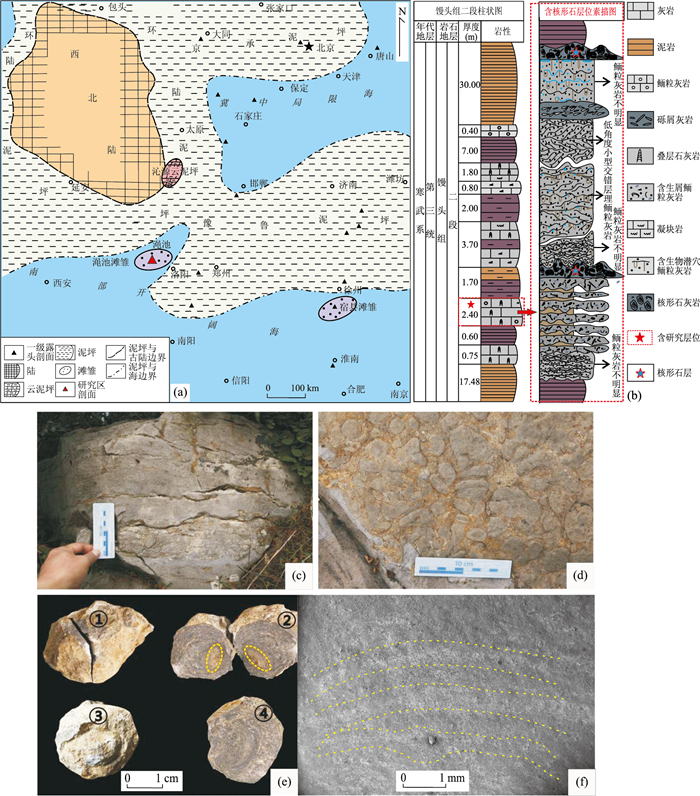
 下载:
下载:
